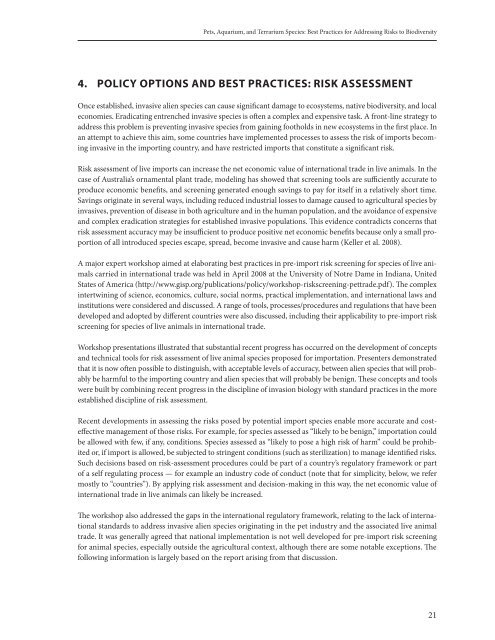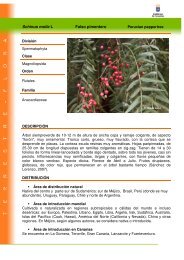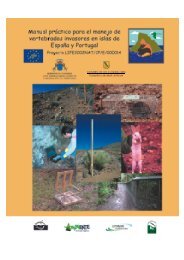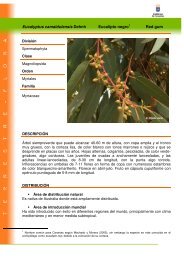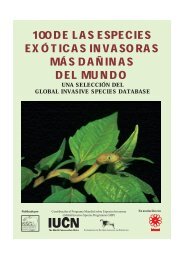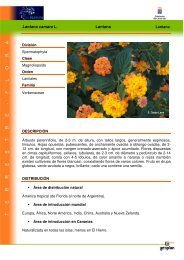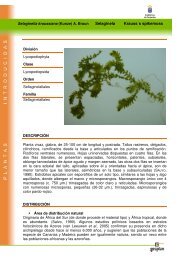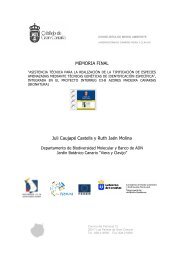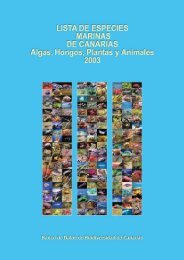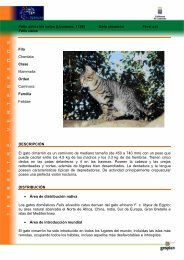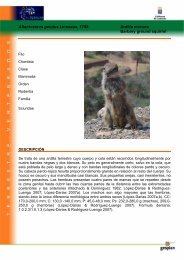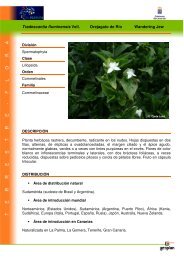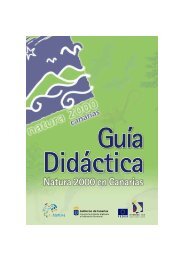Pets, Aquarium, and Terrarium Species - Convention on Biological ...
Pets, Aquarium, and Terrarium Species - Convention on Biological ...
Pets, Aquarium, and Terrarium Species - Convention on Biological ...
You also want an ePaper? Increase the reach of your titles
YUMPU automatically turns print PDFs into web optimized ePapers that Google loves.
<str<strong>on</strong>g>Pets</str<strong>on</strong>g>, <str<strong>on</strong>g>Aquarium</str<strong>on</strong>g>, <str<strong>on</strong>g>and</str<strong>on</strong>g> <str<strong>on</strong>g>Terrarium</str<strong>on</strong>g> <str<strong>on</strong>g>Species</str<strong>on</strong>g>: Best Practices for Addressing Risks to Biodiversity<br />
4. POLICY OPTIONS AND BEST PRACTICES: RISK ASSESSMENT<br />
Once established, invasive alien species can cause significant damage to ecosystems, native biodiversity, <str<strong>on</strong>g>and</str<strong>on</strong>g> local<br />
ec<strong>on</strong>omies. Eradicating entrenched invasive species is often a complex <str<strong>on</strong>g>and</str<strong>on</strong>g> expensive task. A fr<strong>on</strong>t-line strategy to<br />
address this problem is preventing invasive species from gaining footholds in new ecosystems in the first place. In<br />
an attempt to achieve this aim, some countries have implemented processes to assess the risk of imports becoming<br />
invasive in the importing country, <str<strong>on</strong>g>and</str<strong>on</strong>g> have restricted imports that c<strong>on</strong>stitute a significant risk.<br />
Risk assessment of live imports can increase the net ec<strong>on</strong>omic value of internati<strong>on</strong>al trade in live animals. In the<br />
case of Australia’s ornamental plant trade, modeling has showed that screening tools are sufficiently accurate to<br />
produce ec<strong>on</strong>omic benefits, <str<strong>on</strong>g>and</str<strong>on</strong>g> screening generated enough savings to pay for itself in a relatively short time.<br />
Savings originate in several ways, including reduced industrial losses to damage caused to agricultural species by<br />
invasives, preventi<strong>on</strong> of disease in both agriculture <str<strong>on</strong>g>and</str<strong>on</strong>g> in the human populati<strong>on</strong>, <str<strong>on</strong>g>and</str<strong>on</strong>g> the avoidance of expensive<br />
<str<strong>on</strong>g>and</str<strong>on</strong>g> complex eradicati<strong>on</strong> strategies for established invasive populati<strong>on</strong>s. This evidence c<strong>on</strong>tradicts c<strong>on</strong>cerns that<br />
risk assessment accuracy may be insufficient to produce positive net ec<strong>on</strong>omic benefits because <strong>on</strong>ly a small proporti<strong>on</strong><br />
of all introduced species escape, spread, become invasive <str<strong>on</strong>g>and</str<strong>on</strong>g> cause harm (Keller et al. 2008).<br />
A major expert workshop aimed at elaborating best practices in pre-import risk screening for species of live animals<br />
carried in internati<strong>on</strong>al trade was held in April 2008 at the University of Notre Dame in Indiana, United<br />
States of America (http://www.gisp.org/publicati<strong>on</strong>s/policy/workshop-riskscreening-pettrade.pdf). The complex<br />
intertwining of science, ec<strong>on</strong>omics, culture, social norms, practical implementati<strong>on</strong>, <str<strong>on</strong>g>and</str<strong>on</strong>g> internati<strong>on</strong>al laws <str<strong>on</strong>g>and</str<strong>on</strong>g><br />
instituti<strong>on</strong>s were c<strong>on</strong>sidered <str<strong>on</strong>g>and</str<strong>on</strong>g> discussed. A range of tools, processes/procedures <str<strong>on</strong>g>and</str<strong>on</strong>g> regulati<strong>on</strong>s that have been<br />
developed <str<strong>on</strong>g>and</str<strong>on</strong>g> adopted by different countries were also discussed, including their applicability to pre-import risk<br />
screening for species of live animals in internati<strong>on</strong>al trade.<br />
Workshop presentati<strong>on</strong>s illustrated that substantial recent progress has occurred <strong>on</strong> the development of c<strong>on</strong>cepts<br />
<str<strong>on</strong>g>and</str<strong>on</strong>g> technical tools for risk assessment of live animal species proposed for importati<strong>on</strong>. Presenters dem<strong>on</strong>strated<br />
that it is now often possible to distinguish, with acceptable levels of accuracy, between alien species that will probably<br />
be harmful to the importing country <str<strong>on</strong>g>and</str<strong>on</strong>g> alien species that will probably be benign. These c<strong>on</strong>cepts <str<strong>on</strong>g>and</str<strong>on</strong>g> tools<br />
were built by combining recent progress in the discipline of invasi<strong>on</strong> biology with st<str<strong>on</strong>g>and</str<strong>on</strong>g>ard practices in the more<br />
established discipline of risk assessment.<br />
Recent developments in assessing the risks posed by potential import species enable more accurate <str<strong>on</strong>g>and</str<strong>on</strong>g> costeffective<br />
management of those risks. For example, for species assessed as “likely to be benign,” importati<strong>on</strong> could<br />
be allowed with few, if any, c<strong>on</strong>diti<strong>on</strong>s. <str<strong>on</strong>g>Species</str<strong>on</strong>g> assessed as “likely to pose a high risk of harm” could be prohibited<br />
or, if import is allowed, be subjected to stringent c<strong>on</strong>diti<strong>on</strong>s (such as sterilizati<strong>on</strong>) to manage identified risks.<br />
Such decisi<strong>on</strong>s based <strong>on</strong> risk-assessment procedures could be part of a country’s regulatory framework or part<br />
of a self regulating process — for example an industry code of c<strong>on</strong>duct (note that for simplicity, below, we refer<br />
mostly to “countries”). By applying risk assessment <str<strong>on</strong>g>and</str<strong>on</strong>g> decisi<strong>on</strong>-making in this way, the net ec<strong>on</strong>omic value of<br />
internati<strong>on</strong>al trade in live animals can likely be increased.<br />
The workshop also addressed the gaps in the internati<strong>on</strong>al regulatory framework, relating to the lack of internati<strong>on</strong>al<br />
st<str<strong>on</strong>g>and</str<strong>on</strong>g>ards to address invasive alien species originating in the pet industry <str<strong>on</strong>g>and</str<strong>on</strong>g> the associated live animal<br />
trade. It was generally agreed that nati<strong>on</strong>al implementati<strong>on</strong> is not well developed for pre-import risk screening<br />
for animal species, especially outside the agricultural c<strong>on</strong>text, although there are some notable excepti<strong>on</strong>s. The<br />
following informati<strong>on</strong> is largely based <strong>on</strong> the report arising from that discussi<strong>on</strong>.<br />
21


